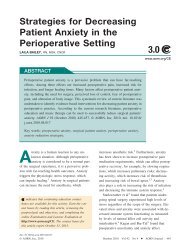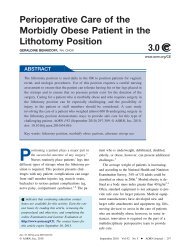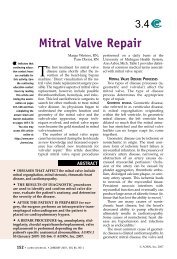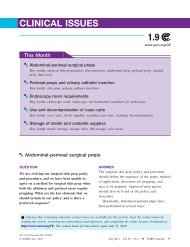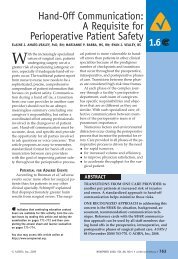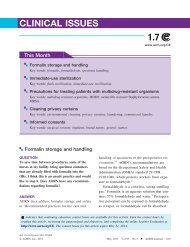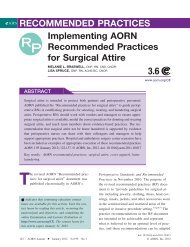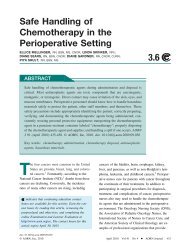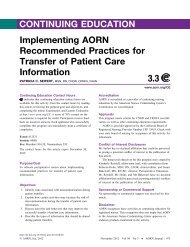Responding to Amniotic Fluid Embolism - AORN
Responding to Amniotic Fluid Embolism - AORN
Responding to Amniotic Fluid Embolism - AORN
Create successful ePaper yourself
Turn your PDF publications into a flip-book with our unique Google optimized e-Paper software.
JUNE 2009, VOL 89, NO 6Dobbenga-RhodesTABLE 1Nursing Care Plan for Patients Who Experience<strong>Amniotic</strong> <strong>Fluid</strong> <strong>Embolism</strong> [applicable PNDS code]DiagnosisRisk forineffectivecoping [X68];compromisedfamily coping[X14]; interruptedfamilyprocesses[X15]; andrisk forimpairedparent/infant/childattachment[X39]Nursing interventions• Identifies psychosocial status [I68] and barriers<strong>to</strong> communication [I134], determinesknowledge level [I135], and notes sensoryimpairment [I90].• Assesses readiness <strong>to</strong> learn [I136] and copingmechanisms [I137].• Elicits family members’ perceptions of surgery[I32].• Identifies individual values and wishes concerningcare [I63].• Verifies consent for the planned procedure[I124].• Explains expected sequence of events and reinforcesteaching about treatment options [I56].• Implements measures <strong>to</strong> provide psychologicalsupport [I147].• Includes the patient and family members inpreoperative teaching [I79] and dischargeplanning [I80] and provides time for the patientand family members <strong>to</strong> ask questions.• Provides status reports <strong>to</strong> family members[I109].• Provides information and explains thePatient Self-Determination Act [I103].• Evaluates psychosocial response <strong>to</strong> the planof care [I147].• Assesses risk for inadvertent hypothermia[I131].• Implements thermoregulation measures [I78]by:• ensuring ongoing intraoperative andpos<strong>to</strong>perative moni<strong>to</strong>ring of core bodytemperature with the appropriate method(eg, tympanic, distal eso phagus, naso -pharynx, pulmonary artery);• preheating the OR and postanesthesiacare unit (PACU) <strong>to</strong> 26° C (78.8° F);• using effective skin-surface warming methods(eg, forced-air warming, circulatingwatergarments, energy transfer pads) preoperativelyand intraoperatively and contin -uing their use in the PACU as needed;• warming IV and irrigation solutions <strong>to</strong>near 37° C (98.6° F) with appropriatewarming equipment according <strong>to</strong> manufacturers’instructions; and• assisting the anesthesia care provider <strong>to</strong>humidify and warm the patient’s airway.• Evaluates response <strong>to</strong> thermoregulationmeasures [I55].Outcomeindica<strong>to</strong>rThe patient,when applicable,and family membersverbalize understandingofthe procedure,sequence ofevents, and expectedoutcomes;demonstrateknowledge ofemotional responses<strong>to</strong> surgeryand the diseaseprocess; andverbalize de -creased anxietyand an ability <strong>to</strong>cope through outthe perioperativeperiod.The parent and infantdemonstrateappropriate bonding.OutcomestatementThe patien<strong>to</strong>r familymembersdemonstrateknowledgeof expectedresponses <strong>to</strong>the surgicalprocedure[O31].The patien<strong>to</strong>r familymembersparticipate indecisionsaffecting theperioperativeplan of care[O23].Risk forbody temperatureimbalance[X57]The patient’stemperature isgreater than 36° C(96.8° F) at thetime ofdischarge fromthe OR.The patientis at orreturning <strong>to</strong>normothermyat the conclusionof theimmediatepos<strong>to</strong>perativeperiod[O12].1082 • <strong>AORN</strong> JOURNAL



